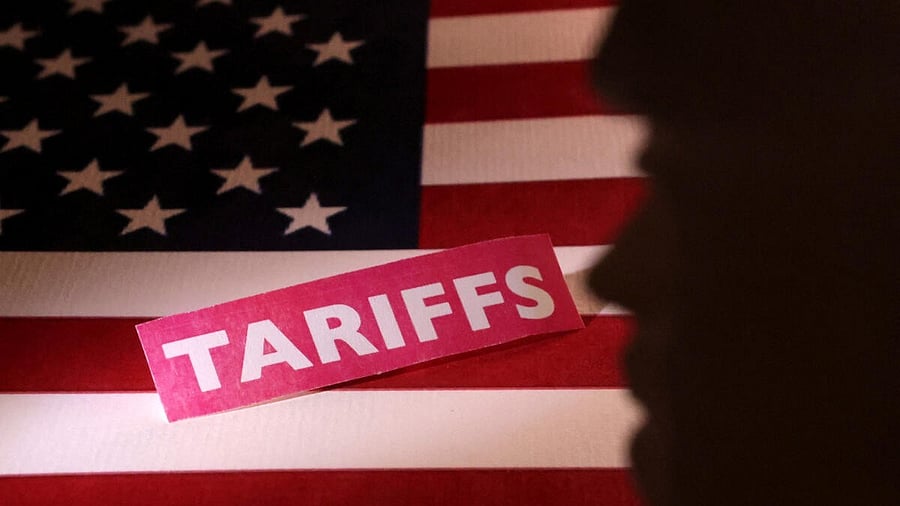
Illustration shows 3D-printed figure of US President Trump, US flag and "tariffs" label.
Credit: Reuters Photo
The bombardment of tariffs by the United States have caused significant setbacks to the global economic order over the past week. This has led to a slowdown in trade, a stock market crash, and researchers are also predicting that it may lead to a global economic recession and an increase in the price of goods.
The retaliatory tariffs that will potentially be put in place by China and the European Union (EU) will only serve to accelerate the aforementioned problems. Despite this, there is a silver lining in these tariffs for India as these tariffs can potentially be used to emerge as a stronger global player in the field of International commerce.
Improving trade relations with other nations and establishing new trade partners
The tariffs have forced many nations to look for new trade partners in order to mitigate the potential losses that could be caused by a barrier to trade due to US tariffs. India can potentially step up and become a major trade partner for a number of nations as bilateral trade with the USA may potentially dwindle due to sanctions.
This can already be seen in China’s recent move to “seek India’s support amidst a trade war with the USA.” Yu Jing, spokesperson for the Chinese embassy in India, in a post on X said, ”China-India economic and trade relationship is based on complementarity and mutual benefit. Facing the US abuse of tariffs, which deprives countries, especially Global South countries, of their right to development, the two largest developing countries should stand together to overcome the difficulties.”
The current global uncertainty following the imposition of sweeping tariffs has also caused the EU to explore a free trade agreement (FTA) with India. The 10th round of negotiations occurred in Brussels last month and more talks are expected in May.
An EU official added that the talks are moving in a positive direction and the momentum is also building. The EU has demanded for significant duty cuts in automobiles and medical devices, besides seeking tax reduction in wines, spirits and a strong intellectual property regime.
If an agreement is reached, Indian exports to the EU, such as ready-made garments, pharmaceuticals, steel, petroleum products, and electrical machinery, can become more competitive and thus be able to sell more.
Undercutting export prices of the countries that are hit harder with tariffs
India now has a significant opportunity to overtake competitors in various fields as higher tariffs on rivals. For instance, China and Bangladesh, stiff competitors in the export of textiles and garments, have received significantly higher tariffs compared to India, giving India a natural competitive advantage in the sector. Furthermore, India has gained an advantage in the electronics, smartphone and telecom sector as rivals like Thailand, Vietnam and China lose their competitiveness due to heavy tariffs.
“As global brands seek to diversify supply chains away from high-tariff countries, India can emerge as a preferred destination for new manufacturing setups and component assembly lines,” said a report by the Global Trade Research Initiative (GTRI).
A recent report by Reuters shines light on how tech giant Apple chartered cargo flights from India to ferry 600 tons of iPhones and other Apple products to America after it stepped up production there to beat the tariffs. This also shows how India has strong chances of benefiting from increased investments from corporations looking to mitigate losses from US tariffs.
Negotiating better deals
The recent pause on tariffs for a period of 90 days provides temporary relief to many Indian exporters and is a great opportunity for India to try and negotiate a new trade deal with the USA. This decision additionally provides a crucial window for pushing the talks on the proposed bilateral trade agreement between India and the US.
Besides the US, the tariffs also act as a huge opportunity for India to negotiate good deals with a number of other trade partners, evident by the progress of the FTA agreement with the EU. The tariffs also allow Indian businesses to acquire raw materials from sources that are heavily impacted by American tariffs.
A report by the Economic Times noted that “Chinese electronics components manufacturers, panicked by the tariff war with the US, are offering to drop prices by up to 5 per cent as Indian companies start negotiating fresh sourcing contracts," which serves to corroborate the significant opportunities that Indian businesses have due to the current economic conditions.
Utilising the falling value of the US Dollar to improve India’s economy
The economic slump in the USA, largely brought on by the imposition of tariffs on a large number of countries, has caused a fall in the value of the dollar. This in turn, has strengthened the value of the rupee which improves India’s buying power. The Indian Rupee, boosted by the dollar's weakness and position unwinding, is trading near its yearly high, a report said.
A strong rupee can potentially give India an opportunity to import things for cheaper, which in turn will allow India to invest more into infrastructure and production and this can also potentially make life for consumers in India better as the value of the currency acts as a regulator for the price of goods and services.